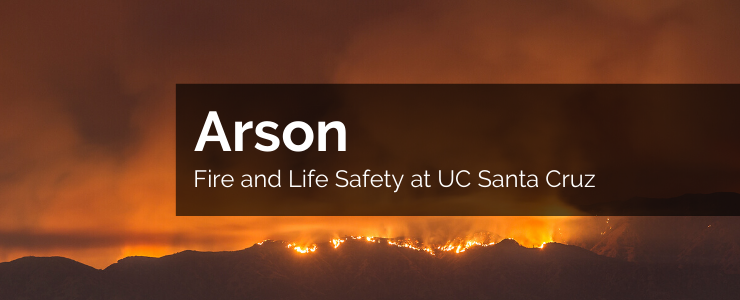Arson
Arson is defined as the crime of willfully and maliciously setting fire to a property. Every year, UC Santa Cruz experiences cases that have a high probability of being arson. Considering that our campus has a high level of fire risk, arson is a serious threat to the health and safety of our community.
This page was developed in partnership with the UCSC Police Department (UCPD) for the purpose of informing you about what counts as arson, ways that the campus attempts to mitigate it, and how you can report behavior that may be arson.
Arson Clarified
Arson is a life-threatening crime regardless of the cause. Whether the cause is pranking, expressions of activism, or panicking members of our community. Despite the origin, arson is arson. You should not set fire to any property on campus regardless of the context. The possibility of rapid fire spread on campus and the subsequent endangering of our community is taken seriously by the Designated Campus Fire Marshal and the UCSC Police Department.
Under the California State Penal Code (§451), all instances of arson are considered a felony.
More Information
NFPA Intentional Fire Fact Sheet (PDF)
Campus Fire Safety - Arson and Pranks (PDF)
Children and Fire-Setting
A plurality of fires are caused by children playing. Playing with fire is extremely dangerous and can have catastrophic repercussions for our community. It is essential that any children living or playing on campus are well supervised.
We recommend that those with children discuss fire safety and best practices with them. There are resources available to help with these conversations.
More Information
NFPA Playing With Fire Fact Sheet (PDF)
Reporting Arson
If you witness behavior that is clearly the setting of fire on campus property, we encourage you to report it immediately by calling 9-1-1. You can also report suspicious behavior or report anonymously using these resources:
- UCPD Suspicious Behavior Reporting: 831.459.2231 (Ext. 1)
- UCPD Anonymous Tip Line: 831.459.3TIP (3847)
When reporting arson or any other behavior, it will be important to provide the who, what, when, where, and how. Keep in mind the following:
- The location where it is happening, if you saw someone suspicious, where did they go or were last seen?
- What kind of fire is happening? Structure, grass, vehicle?
- What details can you acquire about the person(s) responsible? Clothing, build, height?
- When did this occur?
- How did the fire start? Matches, molotov cocktail, object set on fire?

